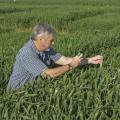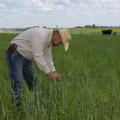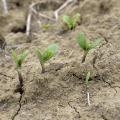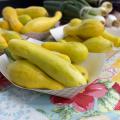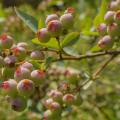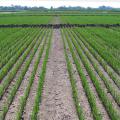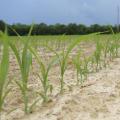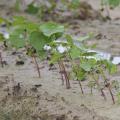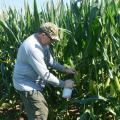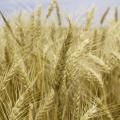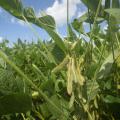Crop Report from 2017
STARKVILLE, Miss. -- Despite almost everything working against this year's winter wheat, benefits remain on the fields growers managed to plant after last fall's drought.
Brian Williams, an agricultural economist with the Mississippi State University Extension Service, said the 2016-17 season makes four consecutive years of reduced wheat acres.
"The state's farmers planted about 60,000 acres of wheat late last fall, which was about 5,000 fewer acres than the previous year," Williams said.
STARKVILLE, Miss. -- Strong export demand for cotton and soybean is causing Mississippi producers to shift away from corn and rice as they finalize their planting plans for 2017.
The U.S. Department of Agriculture Prospective Plantings report released March 31 estimates the state's growers will plant a total of about 4.194 million acres, a 170,000-acre increase over 2016 acreage.
STARKVILLE, Miss. -- Fall preparation paid off for many Mississippi corn producers who were able to take advantage of a gap in spring rains to plant much of their crop early.
Erick Larson, corn specialist with the Mississippi State University Extension Service, said warm weather and a break in typical spring rains has allowed farmers to make considerable corn planting progress this spring.
STARKVILLE, Miss. -- Growing conditions first helped but then hurt Mississippi strawberries this year as the 2017 harvest season comes to an early conclusion.
Eric Stafne, fruit crops specialist with the Mississippi State University Extension Service, said a mild fall and winter helped the crop mature a little earlier than normal.
STARKVILLE, Miss. -- Last year's drought will likely affect this year's hay acreage in Mississippi.
Rocky Lemus, forage specialist with the Mississippi State University Extension Service, said he anticipates about 690,000 hay acres. The state had about 750,000 acres devoted to hay production in 2016.
STARKVILLE, Miss. -- Many Mississippi peanut growers are just now planting this year's crop, but their acreage will likely be increased over the amount cultivated in recent years.
The U.S. Department of Agriculture projects 44,000 acres of peanuts will be planted this year, which would be a jump from 39,000 planted in 2016.
Jason Sarver, peanut specialist with the Mississippi State University Extension Service and a researcher with the Mississippi Agricultural and Forestry Experiment Station, said he believes the state’s peanut fields could approach 50,000 acres.
STARKVILLE, Miss. -- Mississippi producers have planted a large percentage of the state's soybean crop well ahead of schedule, giving producers the opportunity for maximum yields.
The May 1 crop progress and condition report from the U.S. Department of Agriculture estimated 69 percent of the soybean crop has been planted. In the last five years, just 38 percent of the crop was typically planted by this date.
Trent Irby, soybean specialist with the Mississippi State University Extension Service, called the progress to date phenomenal.
RAYMOND, Miss. -- This year's early spring temperatures allowed some fruit and vegetable growers to plant their crops a little earlier than usual.
Jeremy Maness, Mississippi State University Extension agent in Smith County, said growers in his county have not experienced any problems so far despite a late freeze.
"Everything is going well," he said. "Tomatoes grown in greenhouses or high tunnels are ready now. We project watermelons will be ready around mid- to late June, and field tomatoes should be ready to start coming off the vine around the first week of June."
WAYNESBORO, Miss. -- The demand for fresh Mississippi blueberries may grow this year after a mid-March freeze hampered production in neighboring states.
Freezing temperatures during the crop's early growth stage on farms east of the state, especially in Georgia and North Carolina, caused production losses of up to 50 percent.
Meanwhile, 85 percent of Mississippi's blueberry crop was either in good or excellent condition as of May 15, according to a weekly crop progress and condition report published by the U.S. Department of Agriculture.
STARKVILLE, Miss. -- Fewer dairy cows than last year roam Mississippi pastures, so the state's milk production continues to steadily decline.
In the first quarter of 2017, milk production was down 7 percent from that time a year ago. From January to March of 2016, producers collected 42 million pounds of milk compared to 39 million pounds this year.
RAYMOND, Miss. -- Although favorable spring weather helped many producers plant their corn, cotton and soybean crops early, most growers now need fields to dry out.
Well-timed early spring rains helped corn producers avoid irrigating their crops, but flooding from recent excess rain will force some to think about replanting with soybeans.
STONEVILLE, Miss. -- Mississippi growers have flooded many of their rice fields now, but not before rains caused crop management challenges.
Bobby Golden, a rice and soil fertility agronomist with the Mississippi State University Extension Service, said that even though rice is flooded for the majority of the growing season, excess rains and wet weather can complicate crop establishment and management.
STARKVILLE, Miss. -- Insect pressure and a stagnant market are pushing Mississippi growers away from planting grain sorghum.
Compared with 2015, when the state had 120,000 acres of sorghum, producers harvested only about 11,000 acres of the crop in 2016. The U.S. Department of Agriculture forecasted they would plant only 10,000 acres this year. If that prediction holds, 2017 will mark an 88-year low for sorghum production.
STARKVILLE, Miss. -- Tropical Storm Cindy did not help the state's cotton crop that struggled with cool and wet weather all spring.
Darrin Dodds, cotton specialist with the Mississippi State University Extension Service, said in mid-June, cotton received about a week of the heat and sun it needs to thrive. Weather before that was not ideal, and rain remains in the forecast.
RAYMOND, Miss. -- A balance of timely rain and sunny skies is essential for large, sweet watermelons, but too much rain can wreak havoc on the melons and hit producers in the wallet.
Although most of Mississippi's watermelon crop is in good to fair condition, some producers are losing melons because of excess rain.
DODDSVILLE, Miss. -- Production is the least of Ben Pentecost's worries for his catfish farm this summer. If anything, he has too many fish.
"I think our supply is larger now than in recent years, and demand is about the same," said Pentecost, co-owner of the Pentecost Brothers catfish farm in Sunflower County. "We have a backlog of bigger-sized catfish, which processors are pushing back on, but the fish keep getting even bigger the longer they stay in the ponds."
STARKVILLE, Miss. -- Early or not, Mississippi’s corn crop is well on the way to its best yield in years, barring any major disasters.
Erick Larson has spent more than two decades as the Mississippi State University Extension Service corn specialist. Larson said 2017 weather generally has been better than he can remember for any past growing season. Timely rains in some areas and cool nights during the crucial early grain-filling periods were important keys.
STARKVILLE, Miss. -- Mississippi growers produced good wheat yields despite planting historically low acreage and experiencing challenging conditions this year.
According to the U.S. Department of Agriculture, state growers harvested an estimated 40,000 acres of wheat in 2017, averaging an estimated 63 bushels an acre. Average wheat planting is about 200,000 acres annually, but it was as high as 500,000 acres in 2008. The state's record high wheat yield per acre is 64 bushels, set in 2011.
STARKVILLE, Miss. -- Most of the state's soybean crop has a very good yield potential despite some challenges coming late in the season.
Trent Irby, soybean specialist with the Mississippi State University Extension Service, said growers planted more than 60 percent of the crop in April.
"We had more soybeans planted in April than we've had in years," Irby said. "We had several windows that month where it was warmer than usual and dry enough to plant, and growers took advantage of those planting opportunities."
RAYMOND, Miss. -- Mississippi's poultry industry remains healthy with a strong demand for broilers and a positive outlook for the remainder of 2017.

